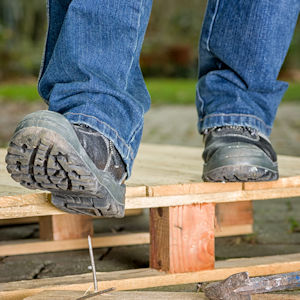05.E Protective Footwear.
05.E.01
Protective footwear that is rated to protect against the hazard(s) identified in the PHA/AHA must be provided and worn.

05.E.02
All protective footwear must meet ASTM F2413 standards.
05.E.03
Add-on type devices, such as strap-on foot, toe or metatarsal guards, must not be used as a substitute for protective footwear and must be demonstrated by the employer to be equally effective via independent testing data for these devices.
05.E.04
For activities in which USACE or contractor personnel or official visitors are potentially exposed to foot hazards, the applicable PHA/AHA, APP, or project safety and health plan must include an analysis of, and prescribe specific protective measures to be taken for, reducing foot hazards.
05.E.05
Personnel must, as a minimum, wear safety-toed boots meeting ASTM Standard F2413 while working on construction sites unless it can be demonstrated by a PHA/AHA to the GDA's satisfaction that a different type of foot protection is required.
05.E.06
Footwear providing protection against impact and compressive forces, conduction hazards, electrical hazards, and sole puncture must comply with the applicable requirements of ASTM F2413. Footwear providing protection against impact and compression hazards must be rated as I/75 and C/75.
- Unexploded ordnance (UXO) personnel whose job tasks required protective footwear but require no metal parts in or on their footwear must wear Conductive footwear (Cd) with protective toe cap/composite toe footwear.
- Personnel participating in wild land fire management activities must wear leather lace-up boots with slip-resistant soles, such as a hard rubber lug-type or tractor tread, a top height of 8 in (20.3 cm) or more with composite toes. Soles must not be made of composition rubber or plastic, which have low melting points.
Knowledge Check Choose the best answer for the question.
5-7. Personnel must, as a minimum, wear safety-toed boots meeting _____ requirements while working on construction sites unless a different type of foot protection is required.
You forgot to answer the question!
